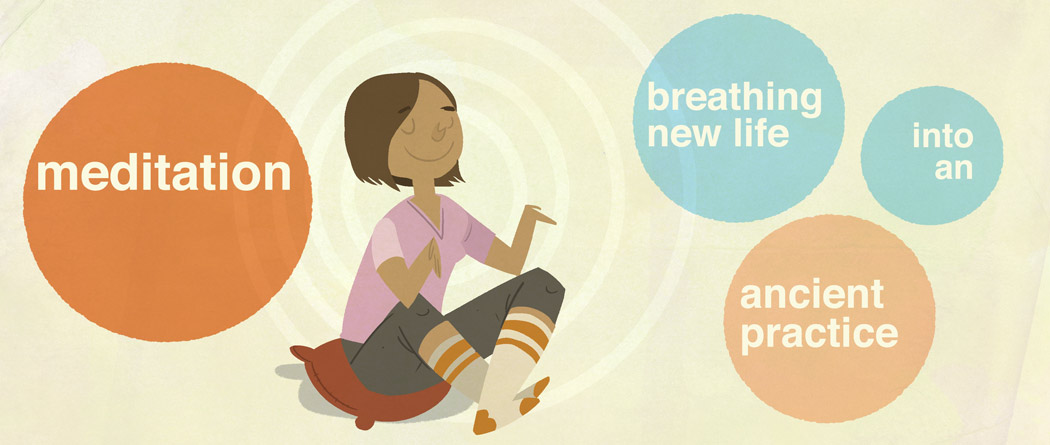
California has always been open to the next new thing, whether a technology, a vintner’s innovation, or what the cultural winds blow in from over the Pacific. That’s how I first tried meditation, back when I was a student at the University of California in Berkeley, then the epicenter of the try-any-new-thing attitude.
As a competitive undergrad, my first impression of meditation was that it eased my worries. I used it as an anti-anxiety measure. Like a pill, I took it morning and evening. Those late in the day sessions proved another benefit: as a chronically sleep-deprived sophomore, I would nod off for a nap as soon as my meditation started.
When I went on to study psychology at Harvard, I did my doctoral research on how meditation helps us recover from stress. But I was ahead of the curve in my interest; my professors thought I was a bit batty to take a serious interest in what was then an exotic method.
Now, though, the meditation story has changed. Several decades of research, including state-of-the-art brain imaging, reveal that this simple method trains the mind and shapes the brain, with a basket of benefits that ranges from sharpened concentration to lower blood pressure. Medical clinics routinely teach meditation to patients with chronic diseases from arthritis to diabetes to help them live better with their symptoms. And businesses are offering their employees the chance to learn meditation in order to improve performance.
Meditation refers to a range of techniques, from mantra repetition to mindfulness, which all share a common cognitive method. It boils down to retraining attention. Research at Harvard has found that our minds wander on average 50% of the time, that is, when we’re trying to focus, our minds are elsewhere.
Meditation trains attention by having us focus on one target (such as a mantra or the breath). Then comes the crucial difference between meditation and other ways to relax, whether exercising or spacing out online: in meditation, when we notice our minds wandering, we bring them back to a mental target and keep them there. Then when it wanders again, repeat. And again and again.
Brain imaging studies of this simple mental process, done at Emory University, find that the mental circuitry for focusing on what’s important becomes stronger. Attention is a mental muscle, and every time we repeat this cycle it’s like lifting a weight: each repetition makes us just a bit stronger. And focusing on what’s important is what every leader, student, coach – anybody – needs to thrive.
The research shows that this mental gym pays off after the session, throughout our day: meditation enhances people’s ability to concentrate, to keep their minds from wandering too much, and to focus in general. “Every time my mind wanders off during a business meeting,” one executive told me, “I ask myself, What opportunity did I just miss?”
A bonus here is that the same strips of neurons that help us focus also are crucial for managing our distressing emotions. The longer people have been meditators, the better their bodies become at recovering from the agitation of stress.
The biological advantages from a faster physiological recovery from upsets include a stronger immune system, lower blood pressure, and more stable blood sugar levels, just to mention a few.
When researchers at the University of Wisconsin taught mindfulness to stressed-out workers at a biotech startup, they found remarkable changes after eight weeks (average daily practice time: 30 minutes). Mindfulness led to a shift in the centers that control moods: they went from anxious and stressed to upbeat and enthusiastic. Spontaneously, they recalled what inspired them about their work. And, to the researchers’ surprise, their mindfulness also resulted in a boost in immune effectiveness.
A caution, though, if you’re thinking of starting meditation. Many people expect that they will somehow experience a high during the session. But the practice is more like going to the gym: at first it can be a struggle, though it gets easier over time. Many first-timers report, for instance, that their minds are more wild than ever during meditation, actually a sign that they are finally paying attention to how often our minds wander.
The real payoffs come during your day, not necessarily during the meditation session. Don’t expect miracles; the changes are gradual and can be subtle. Dan Harris, the ABC news anchor, calls it “ten percent happier” in his account of why he meditates. But the improvements are real, as research studies verify.
The CEO of a construction firm, a meditator himself, asked me to share these methods with those working at his headquarters. Understandably many were dubious. But I approach the method as a way to train the mind, not as some woo-woo magic, and the science behind it brought people around enough to give it a try. The CEO later told me the most enthusiastic person turned out to be his head of HR; she organized an ongoing meditation group there. And she was initially one of the skeptics.
Now that I’m in my 60s, the finding I like best comes from Harvard Medical School: some parts of the brain that shrink with aging actually seem to grow larger and their neurons more densely connected in meditators!
This article originally appeared in The Private Journey Magazine.
Additional resources:
The Meditative Mind: The Varieties of Meditative Experience
Relax: 6 Techniques to Lower Your Stress
Working with Mindfulness Ebooks
Training the Brain: Cultivating Emotional Skills
Bridging the Hearts and Minds of Youth 2012 and 2013 Conference Videos







